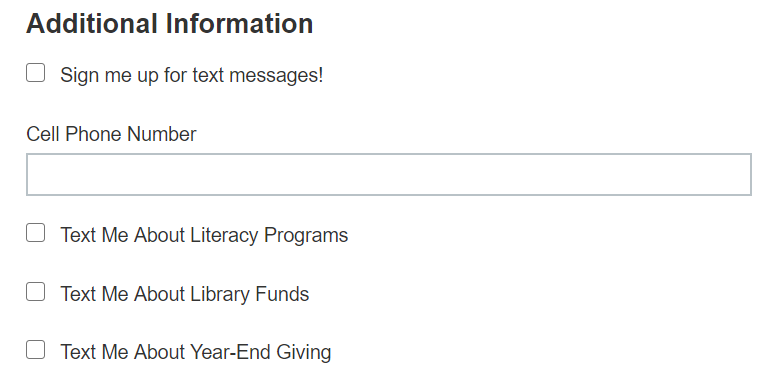Texting your nonprofit’s supporters is a great way to get them to donate to your cause, register for events, or help with special requests. Just because you have your donors’ phone numbers doesn’t mean you should start sending uninvited texts. With great power comes great responsibility, after all. An uninvited text fundraising request not only risks hurting your relationship with your donor, it can risk your organization’s reputation.
The Telephone Consumer Protection Act specifically forbids businesses texting consumers without their consent. However, nonprofits have an advantage over other businesses. Nonprofit organizations don’t require written consent. Donors consent to texts simply by providing their cell phone number. But how do you get supporters to opt in to receive texts in a way that makes them actually want to receive text messages from you? Use these four text message opt-in best practices to encourage your community to sign up for your texts.
Make opting in easy
The hardest part of getting supporters to opt in to text fundraising messages from your organization shouldn’t be the process of opting in. Instead, you can incorporate an opt-in ask on an online donation form, volunteer sign up form, during event registration, or when subscribing to your organization’s newsletter.
Adding an opt-in field to your form that’s specific to text messaging is simple. After asking for the supporter’s cell phone number, ask them to check a box if they’d like to receive texts from you. When users choose to opt in on the form, add their number to your text messaging contact lists. The process should be as simple as asking for a cell phone number and offering supporters the choice to receive your texts. Because it’s so simple to ask for their consent, there’s no reason not to ask for it!

Another easy option to sign supporters up for text messages is keyword registration. You can promote your keyword on social, in email, and other donor communications. To opt in, your supporters would just send a unique keyword to your organization’s text message number. They can subscribe themselves to your text message contact list and it counts as consent to text. Companies ranging from huge corporations to mom and pop shops have built substantial text message contact lists with a corporate keyword. If you send a diverse array of texts that may not be relevant to everyone in your contacts list, set up additional keywords and maintain separate lists.
Be transparent about your text message program
This text message opt-in best practice works wonders for keeping your text contact list happy. Be transparent about your text message program. Answer questions such as:
- How often does your organization text its contact lists?
- How many messages can users expect to receive from your organization?
- Are all texts requests for financial support?
- Do text messages and data rates apply?
These common questions can pose significant barriers to signing up. However, you can alleviate donors’ worries. Be transparent. When donors and volunteers sign up, they should be aware of what they’re signing up for. Decide on an acceptable frequency of text communication and tell potential subscribers what they can expect. Are you reaching out twice a month? Once a week? Only on an irregular, as-needed basis? This is information your supporters need if they’re concerned with running up their phone bills (because believe it or not, phone plans that charge per text still exist today).
In addition to communicating about the frequency of messages, let supporters know what kinds of content you’ll send via text. Are they signing up to receive text messages about a certain event or end-of-year giving reminders? If you know how you plan to run your text message program, let supporters know ahead of time what kind of messages you’ll send via text.
Give supporters text message opt-in options
If your organization does a lot of communicating via text message, then you might need separate signup keywords. This makes it easier to keep separate text message contact lists. If you plan to send text messages for each program offering, give supporters the option to sign up for specific contact lists.
If you have supporters interested in specific programs or communications opt them in to just the communications they want. Creating subject-specific keywords is vital if you have a robust text message program sending many different messages. Smaller nonprofits can have a keyword that encompasses every need, but larger nonprofits may need keywords for each specific purpose. This makes it easy to avoid spamming your supporters.
On your Qgiv forms, you can add custom fields for each area of interest. Supporters can check the boxes of subjects they want texts about. This method requires manually adding supporters to the appropriate contact lists. Another option is to share keywords for those interest areas. This lets people opt in to text messages specifically tailored to topics they’re interested in.
Keep your text message contact lists clean
As your supporters opt in to text messages, it’s important to regularly maintain your contact lists. That means ensuring everyone on your list still consents to text fundraising messages. You’re going to have text message subscribers unsubscribe from your communications. When this happens, it’s important to remove or deactivate the subscriber. Otherwise, you risk damaging your relationship with them.
Manually managing contact lists can be difficult if you have a lot of subscribers. Outbound text messaging services make this easier. For instance, Qgiv’s Mobile Suite automatically deactivates a contact if they unsubscribe from text communications. You’re able to keep sending messages without fear that an unsubscribed user will receive a text message from your organization. The right text messaging service can put minds at ease while maximizing the potential of your text message program.
Conclusion
Your text fundraising program is only as good as the content you send and the size of your contact lists. To keep donors happy, get their consent to text them first. This ensures the people you text want to get your messages. Using these four text fundraising opt-in best practices will help you build a large contact list of willing supporters. Once you’ve got great contact lists, start sending those texts! Need text messaging inspiration? Download our nonprofit text message templates. They provide a great start to your text communication strategy!


